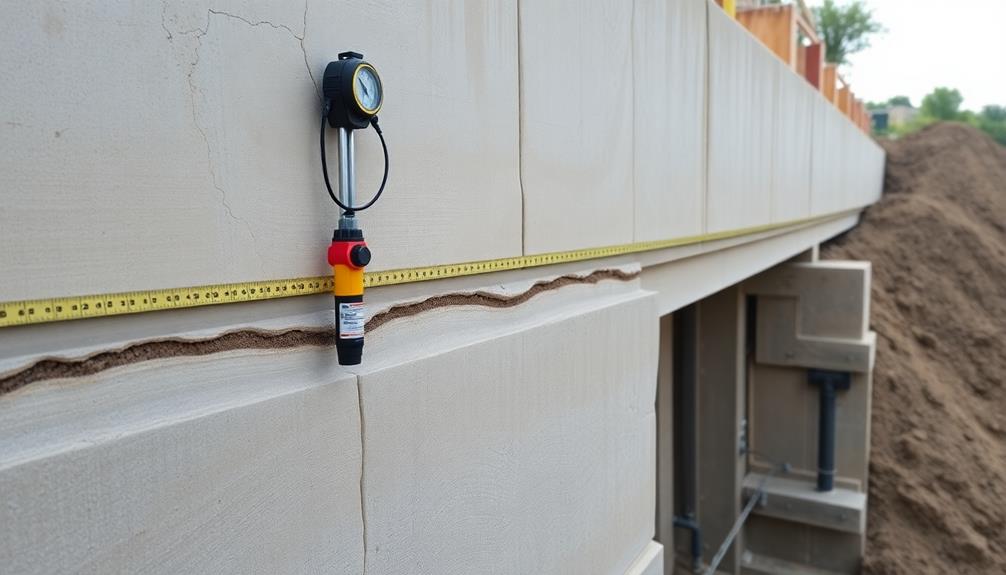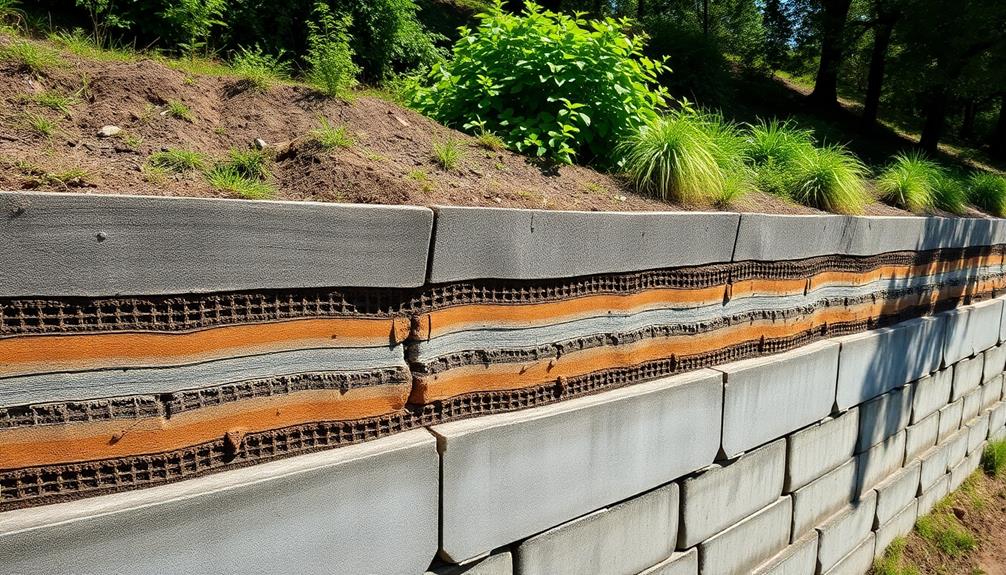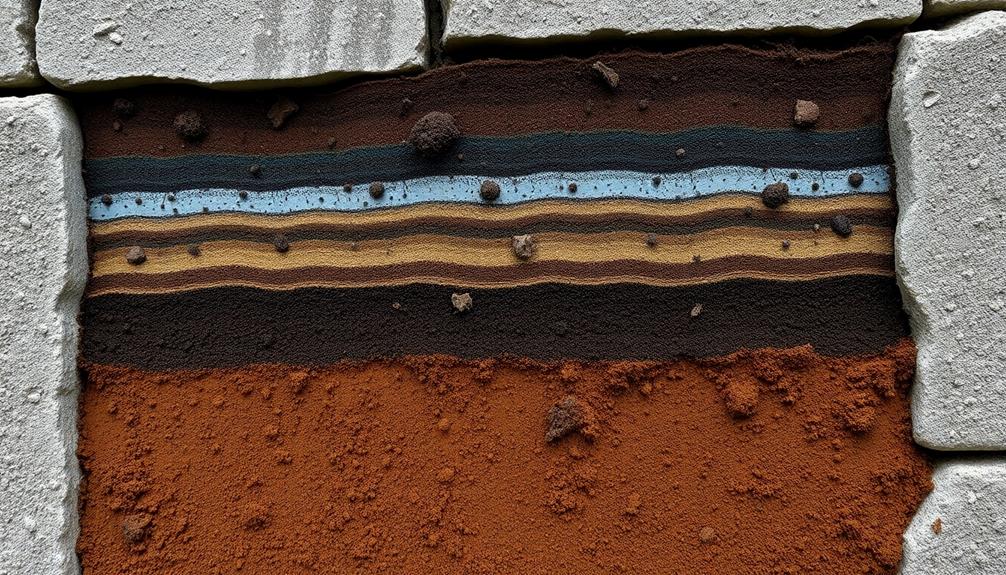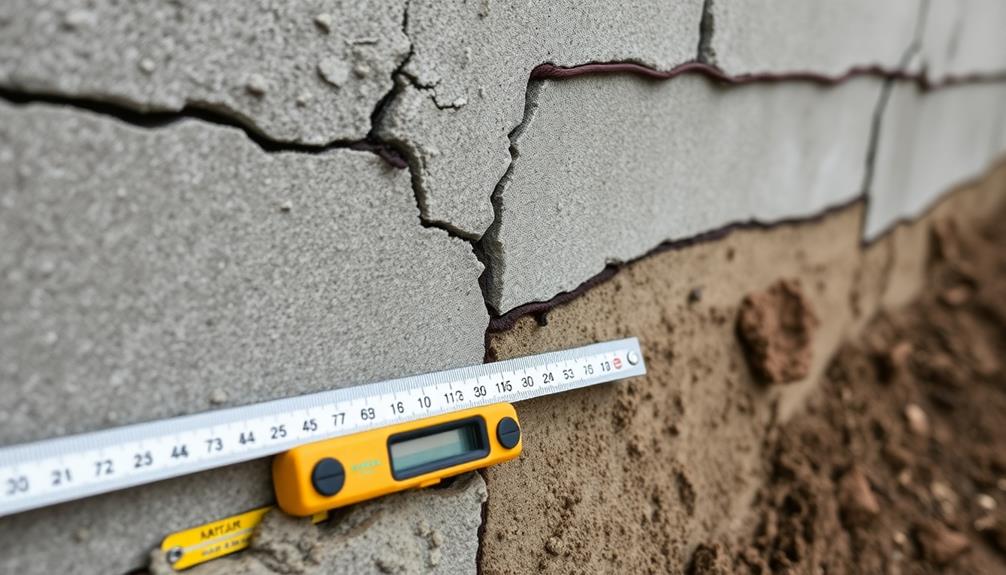Analyzing the structural integrity of retaining walls involves a thorough assessment of load-bearing capacity, soil pressure, material strength, and reinforcement techniques. Engineers conduct detailed soil pressure calculations, evaluate material properties through laboratory testing, and analyze reinforcement systems using finite element analysis and limit equilibrium methods. The process includes examining soil composition, moisture content, and compaction levels to determine optimal wall design and construction. Regular inspections and maintenance are vital for long-term performance optimization. This meticulous approach guarantees the retaining wall can withstand anticipated loads, environmental stresses, and maintain stability over time. A deeper understanding of these factors contributes to enhanced safety and cost-effective solutions for retaining wall projects.
Table of Contents
ToggleWalls Contractor Highlights
- Conduct detailed soil pressure calculations to determine lateral forces exerted on the wall structure.
- Evaluate material strength through laboratory testing and in-situ measurements of concrete, steel, and soil components.
- Analyze reinforcement systems using finite element analysis and limit equilibrium methods to assess effectiveness.
- Perform a comprehensive soil composition analysis, considering factors like soil type, moisture content, and compaction levels.
- Implement ongoing monitoring and maintenance practices, including regular inspections and proactive remedial measures.
Load-Bearing Capacity Assessment

Evaluating the load-bearing capacity of a retaining wall requires a thorough analysis of several critical factors. Engineers must first conduct detailed soil pressure calculations to determine the lateral forces exerted on the wall structure.
These calculations are then combined with a meticulous evaluation of the wall's material strength and an in-depth analysis of its reinforcement techniques to guarantee the wall can withstand the anticipated loads without failure or excessive deformation.
The choice of retaining wall materials plays a pivotal role in determining the overall structural integrity and longevity of the wall. Different materials, such as boulders, limestone, or interlocking concrete blocks, offer varying levels of durability and load-bearing capacity, which must be carefully considered during the assessment process.
Soil Pressure Calculations
To accurately determine the load-bearing capacity of a retaining wall, engineers must perform thorough soil pressure calculations. These calculations involve evaluating the lateral earth pressure exerted on the wall by the retained soil mass. Factors such as soil type, moisture content, and compaction levels significantly influence the magnitude of this pressure. Engineers employ various methods, including Rankine's theory and Coulomb's theory, to estimate both active and passive earth pressures acting on the wall.
The process begins with soil classification and determination of key parameters like unit weight, friction angle, and cohesion. These values are then input into complex equations that account for wall height, backfill slope, and surcharge loads. Advanced software tools often assist in these calculations, allowing for more accurate and efficient analysis.
It is indispensable to consider both static and dynamic loads, particularly in seismic zones where earthquake forces can substantially increase lateral pressures. By meticulously evaluating these factors, engineers can design retaining walls that effectively resist overturning, sliding, and bearing capacity failures. This thorough approach ensures the long-term stability and safety of retaining structures, providing peace of mind for property owners and the surrounding community.
Material Strength Evaluation
The cornerstone of retaining wall design lies in a detailed material strength evaluation, which directly informs the structure's load-bearing capacity assessment. This critical analysis involves examining the mechanical properties of the materials used in construction, including concrete, steel reinforcement, and soil components. Engineers must meticulously assess compressive strength, tensile strength, and shear resistance to confirm the wall can withstand the anticipated loads and environmental stresses.
The evaluation process typically encompasses laboratory testing of material samples, in-situ measurements, and the application of established engineering standards. Concrete core samples are subjected to compression tests, while steel reinforcement undergoes tensile strength assessments. Additionally, the interaction between these materials and the surrounding soil must be carefully considered, as it noticeably impacts the wall's overall stability. Factors such as water content, density, and cohesion of the soil are analyzed to determine their influence on the wall's performance. By conducting an extensive material strength evaluation, engineers can accurately determine the load-bearing capacity of the retaining wall, ensuring its ability to safely resist lateral earth pressures, surcharge loads, and potential seismic forces throughout its intended lifespan.
Reinforcement Analysis Techniques
Building upon the material strength evaluation, reinforcement analysis techniques form a critical component in evaluating a retaining wall's load-bearing capacity. These techniques involve an extensive examination of the structural elements that provide additional support to the wall, ensuring its ability to withstand lateral earth pressures and surcharge loads.
Engineers employ various methods, including finite element analysis and limit equilibrium methods, to assess the effectiveness of reinforcement systems such as geosynthetics, soil nails, or tie-backs.
The process typically begins with a detailed survey of existing reinforcement, followed by an analysis of its distribution, spacing, and anchorage. Sophisticated software models are utilized to simulate different load scenarios, allowing for the identification of potential weak points in the reinforcement network.
Factors such as soil-reinforcement interaction, long-term creep behavior of materials, and environmental effects are meticulously considered. The analysis also encompasses an evaluation of the global stability of the reinforced soil mass, ensuring that the entire system functions cohesively.
Benefits

The benefits of maintaining retaining wall structural integrity extend far beyond mere aesthetics, encompassing vital aspects of safety, economics, and environmental stewardship. Properly constructed and maintained retaining walls greatly enhance the stability of surrounding soil and structures, thereby improving overall safety and reducing the risk of catastrophic failures.
Boulder retaining walls offer a particularly durable and visually appealing option, providing both functionality and natural beauty to landscapes. In addition, investing in robust retaining wall systems proves to be a cost-effective long-term solution, as it not only increases property value but also minimizes the need for frequent repairs and replacements while simultaneously mitigating potential environmental impacts through reduced erosion and land degradation.
Improved Safety and Stability
Enhancing the structural integrity of retaining walls substantially improves safety and stability for both the surrounding environment and nearby structures. When properly designed and constructed, these walls provide essential support to soil masses, preventing erosion, landslides, and potential property damage. By implementing advanced engineering techniques and high-quality materials, retaining walls can effectively withstand lateral earth pressures, hydrostatic forces, and seismic activities.
The improved safety and stability offered by structurally sound retaining walls extend beyond mere physical protection. They create a sense of security for property owners and community members, fostering a collective peace of mind. These robust structures enable the development of previously challenging terrains, expanding usable land and facilitating urban growth.
In addition, well-engineered retaining walls contribute to the longevity of adjacent infrastructure, such as roads, buildings, and utilities, by mitigating soil movement and reducing the risk of foundation settlement. This proactive approach to land management not only enhances public safety but also promotes sustainable development practices, ensuring that our built environment remains resilient and adaptable to changing environmental conditions over time.
Cost-Effective Long-Term Solution
While the safety and stability benefits of well-constructed retaining walls are evident, their cost-effectiveness as a long-term solution is equally remarkable. These structures, when properly designed and installed, offer a durable and efficient means of managing soil retention and erosion control. The initial investment in a high-quality retaining wall pays dividends over time through reduced maintenance costs, increased property value, and extended lifespan of the structure.
Retaining walls provide a sustainable solution for land management, allowing property owners to maximize usable space and mitigate potential hazards associated with soil instability. By preventing soil erosion and managing water drainage, these structures minimize the need for frequent landscaping repairs and reduce the risk of property damage. Additionally, the versatility of retaining wall materials, such as concrete blocks, natural stone, or engineered timber, allows for customization to suit specific site conditions and aesthetic preferences. This adaptability guarantees that the chosen solution not only addresses immediate structural needs but also integrates seamlessly with the surrounding environment, enhancing the overall appeal and functionality of the property for years to come.
Enhanced Property Value
Frequently overlooked, the installation of a well-designed retaining wall can greatly boost a property's value. Beyond its functional purpose of soil retention, a structurally sound retaining wall contributes significantly to the aesthetic appeal and overall landscaping of a property. This enhancement often translates into a higher market valuation, making it an attractive investment for homeowners and real estate developers alike.
A properly constructed retaining wall serves as an indicator of the property's structural integrity, instilling confidence in potential buyers or appraisers. It demonstrates a commitment to long-term maintenance and property improvement, factors that are highly valued in the real estate market. In addition, retaining walls can create additional usable space on sloped terrains, effectively expanding the functional area of the property. This increased utility, combined with improved drainage and erosion control, contributes to a more desirable living environment. As a result, properties featuring well-maintained retaining walls often command premium prices in competitive markets, offering homeowners a tangible return on their investment while simultaneously enhancing their quality of life and sense of belonging within their community.
Environmental Impact Reduction
Retaining walls play an essential role in minimizing environmental impact through various mechanisms. These structures considerably reduce soil erosion, a critical environmental concern that can lead to ecosystem disruption and water pollution. By stabilizing slopes and preventing soil displacement, retaining walls preserve natural habitats and maintain the integrity of surrounding landscapes. Additionally, these structures can mitigate the effects of stormwater runoff by controlling water flow and reducing sediment transport, thereby protecting nearby water bodies from contamination.
Furthermore, retaining walls contribute to sustainable land use practices by maximizing usable space in both urban and rural settings. This efficient utilization of land reduces the need for expansion into undeveloped areas, preserving natural ecosystems and biodiversity. The implementation of green retaining wall systems, incorporating vegetation and permeable materials, can enhance air quality, support local flora and fauna, and contribute to urban heat island reduction. By integrating these eco-friendly design elements, retaining walls not only serve their primary structural purpose but also actively contribute to environmental conservation efforts, fostering a harmonious relationship between built environments and natural ecosystems.
Soil Composition Behind Wall

The soil composition behind a retaining wall plays a vital role in its structural integrity and long-term stability. Proper identification of soil types, analysis of moisture content, and assessment of density and compaction are essential factors in designing and maintaining an effective retaining wall system. These key elements can be evaluated using various geotechnical methods and tests, as outlined in the following table:
| Test Method | Purpose | Equipment |
|---|---|---|
| Sieve Analysis | Soil Type Identification | Sieves, Shaker |
| Atterberg Limits | Moisture Content Analysis | Casagrande Device |
| Proctor Test | Density and Compaction | Mold, Hammer |
Soil Type Identification
Identifying the soil type behind a retaining wall is imperative for ensuring its structural integrity and longevity. Proper soil classification enables engineers and contractors to make informed decisions regarding wall design, drainage systems, and reinforcement requirements. To accurately determine soil composition, professionals employ various field and laboratory tests, including visual-manual procedures, grain size analysis, and Atterberg limits tests.
The unified soil classification system (USCS) serves as a standardized method for categorizing soils based on their engineering properties. This system classifies soils into coarse-grained (gravels and sands) and fine-grained (silts and clays) categories, further subdividing them based on gradation and plasticity characteristics.
Coarse-grained soils are typically more suitable for retaining wall construction due to their superior drainage properties and reduced susceptibility to volume changes. However, fine-grained soils may require additional considerations, such as the implementation of robust drainage systems and the use of geosynthetic reinforcements. By thoroughly examining the soil type behind a retaining wall, engineers can develop tailored solutions that address specific site conditions, ultimately enhancing the wall's performance and durability over time.
Moisture Content Analysis
Moisture content analysis of the soil behind a retaining wall plays a pivotal role in evaluating the structure's stability and long-term performance. This assessment involves determining the amount of water present in the soil, which directly impacts its strength, compressibility, and overall behavior. By understanding the moisture content, engineers and property owners can make informed decisions about drainage systems, reinforcement techniques, and maintenance schedules.
To conduct a thorough moisture content analysis, soil samples are collected at various depths and locations behind the retaining wall. These samples undergo laboratory testing using standardized methods such as oven-drying or nuclear density gauge measurements. The results provide valuable insights into the soil's water retention capabilities, potential for expansion or contraction, and susceptibility to erosion. Additionally, this data helps identify areas of concern where excessive moisture accumulation may lead to increased hydrostatic pressure or compromised soil stability.
Density and Compaction
Soil density and compaction levels behind a retaining wall are critical factors in determining its overall stability and performance. These elements directly influence the wall's ability to withstand lateral earth pressures and maintain its structural integrity over time. Proper compaction of backfill material guarantees that soil particles are tightly packed, reducing the potential for settlement and increasing the soil's shear strength.
To assess density and compaction, geotechnical engineers employ various field and laboratory tests. In-situ density tests, such as the sand cone method or nuclear density gauge, provide valuable data on the soil's current state. Additionally, laboratory proctor tests establish the ideal moisture content for maximum compaction. Engineers analyze these results to determine if the soil meets project specifications and industry standards.
Inadequate compaction can lead to a host of issues, including excessive settlement, increased hydrostatic pressure, and reduced bearing capacity. By meticulously evaluating and controlling soil density and compaction, engineers can substantially enhance the retaining wall's longevity and minimize the risk of structural failure. This all-encompassing approach to soil composition analysis ensures that the retaining wall remains a reliable and durable component of the overall construction project.
Walls Contractor FAQ
How Often Should Retaining Walls Be Inspected for Structural Integrity?
Retaining walls should be inspected annually for structural integrity, with more frequent checks after severe weather events or seismic activity. Regular inspections guarantee the safety of our community and help identify potential issues before they become serious problems.
What Are Signs of Imminent Retaining Wall Failure?
Recognizing signs of imminent retaining wall failure is vital for our safety. Key indicators include bulging or leaning walls, cracks, soil movement, water seepage, and separation between wall segments. Regular inspections help us identify these issues early.
Can Vegetation Growth Affect the Stability of a Retaining Wall?
Certainly, vegetation growth can profoundly impact retaining wall stability. Roots can exert pressure, causing structural damage and compromising integrity. Additionally, excessive moisture retention from plants may lead to soil expansion and increased hydrostatic pressure behind the wall.
Are There Specific Height Limitations for Different Types of Retaining Walls?
Height limitations for retaining walls vary based on material, design, and local regulations. Generally, wood walls are limited to 4 feet, while reinforced concrete or masonry walls can reach 10 feet or more with proper engineering and permits.
How Do Extreme Weather Conditions Impact Retaining Wall Structural Integrity Over Time?
Extreme weather conditions profoundly impact retaining wall integrity over time. Freeze-thaw cycles, heavy rainfall, and temperature fluctuations can cause material degradation, soil erosion, and increased hydrostatic pressure. Regular inspections and appropriate drainage systems are essential for maintaining structural stability.







